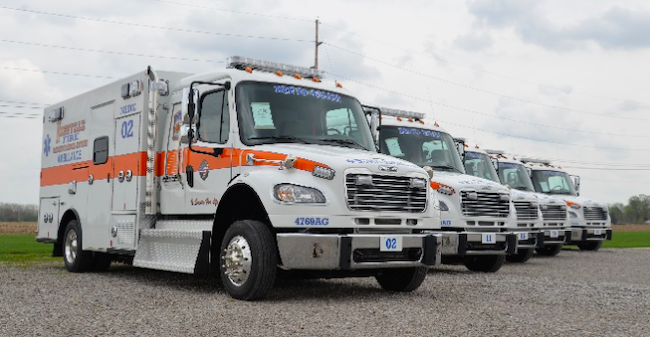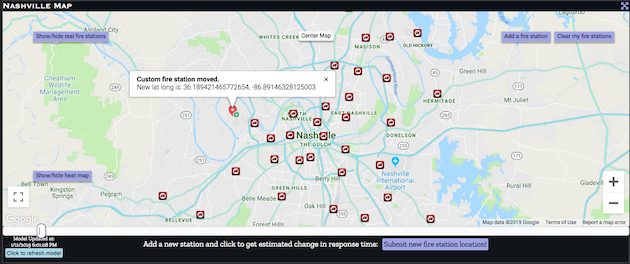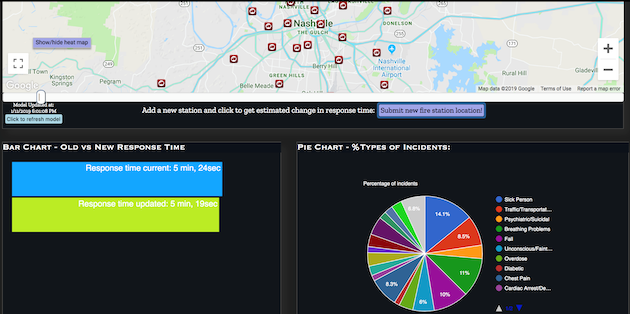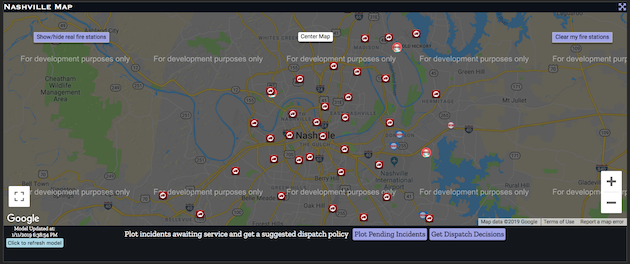
Vanderbilt researchers have discovered a vortex—and this one has nothing to do with icy, polar weather.
Working with the Nashville Fire Department and Davidson County Information Technology Services, a team of Vanderbilt computer scientists and engineers analyzed more than three years of NFD incident data. The team looked at location, time and type of incidents that included motor vehicle accidents, fires and fire alarms and ambulance calls along with the response times for the emergency vehicles dispatched. Data also included incident severity and clearance time. Additionally, the team integrated factors such as traffic congestion, weather, road characteristics and pedestrian traffic.
They found, in effect, a vortex problem, said Geoffrey Pettet, a computer science Ph.D. student on the project.
“A lot of hospitals are clustered near downtown,” Pettet said. “Many of the incidents occur there, too, and when an ambulance is dispatched to an outlying neighborhood they’ll take patients to the nearest hospital but then be sent back downtown.”
The researchers developed models for the city that predicted with high accuracy when and where accidents will happen and delivered a set of prototype, open-source tools the city is testing. Managers can see likely incident distribution across different times. Another feature allows users to add, remove and relocate first-response stations and vehicles around the county to see the effect on response times.

The biggest factor contributing to increased incidents was not weather or traffic—it was the occurrence of other incidents nearby, which creates a cascade effect.
Nashville an ideal test bed
The project is one of several data initiatives with Nashville under the auspices of Vanderbilt Initiative for Smart City Operations and Research. The city’s rapid growth and growing pains make Music City an ideal test bed for what a smart city can be.
Building a foundation for smart city operations with tools and platforms other cities can use is a key goal of this work. In fact, Abhishek Dubey, one of VISOR’s leaders and a senior research scientist at the Vanderbilt Institute for Software Integrated Systems, already has fielded inquiries from several cities about the demo dashboard for fire and EMS simulation and planning Nashville has been evaluating.
Researchers found Nashville emergency officials already did a good job allocating resources. The dashboard and planning tools give the city more information to work with as demands escalate.
“The idea is to move to a proactive rather than reactive emergency response strategy,” said Dubey, assistant professor of computer science and computer engineering.
The city already is looking at applying the model to other Metro departments. “Any time we have a tool to make city resources more efficient it is a plus,” said Colleen Herndon, Metro’s ITS project manager.
“For me, one of the big takeaways is that when operationalized, even in an experimental phase, this gives the Fire Department the data to help justify the need for new stations,” Herndon said. “That is a deeper level of information than they have today. That in itself is a benefit and that is the starting point.”
Foundation for broader application
The research community also has taken note. “There is a lot of interest in the theoretical validity,” said Pettet, who works with Dubey. “This kind of look-ahead approach hasn’t been done before.”
That foundation has broad application to any resource allocation problem with spatial and temporal elements. For cities, that includes services such as public works, road configuration, housing distribution and transit planning.

Connected Nashville: A Vision for a Smarter City accelerated the collaboration. Connected Nashville represents, for the first time, publicly reviewed, set tech-oriented strategies for Metro Government to follow as it addresses stated priorities, including setting security and privacy standards. Dubey served as the technical standards committee co-chair.
“We had lots of discussion, not only on what kind of technologies were available, but how they could be used to solve old problems in new ways,” Herndon said. “We view security and privacy as fundamental requirements for any smart city technology, so having Vanderbilt’s expertise in compiling our technical standards was huge.”
Major grants from the National Science Foundation, the Department of Energy are involved, with Tennessee Department of Transportation and Vanderbilt matches for some projects.
“Our team—faculty, students and stakeholders from the partner communities—explores how emerging technical capabilities of the Internet of Things and advances in data sciences and cyber-physical systems can inform, and be informed by, the social sciences to address critical problems around energy, water, transportation and emergency services,” Dubey said.
The dashboard and a demonstration video can be seen on Github.

Contact:
Pamela Coyle (615) 343-5495
Pam.Coyle@Vanderbilt.edu
Twitter @VUEngineering